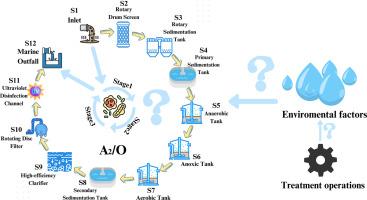当前位置:
X-MOL 学术
›
Water Res.
›
论文详情
Our official English website, www.x-mol.net, welcomes your
feedback! (Note: you will need to create a separate account there.)
Changes in microbial communities across the whole A2/O wastewater treatment process and their drivers - Reduced community diversity but increased proportion of certain pathogens
Water Research ( IF 11.4 ) Pub Date : 2024-11-14 , DOI: 10.1016/j.watres.2024.122790 Xin Hou, Lei Zhang, Yong Zhao, Jiamin Li, Ziming Jiang, Sen Wang, Xiaoran Li, Xiaotong Wang, Xianhua Liu
Water Research ( IF 11.4 ) Pub Date : 2024-11-14 , DOI: 10.1016/j.watres.2024.122790 Xin Hou, Lei Zhang, Yong Zhao, Jiamin Li, Ziming Jiang, Sen Wang, Xiaoran Li, Xiaotong Wang, Xianhua Liu

|
Microorganisms play a crucial role in pollutant removal and water quality stabilizing. However, limited research exists on the microbial variability and the factors driving it at different stages of wastewater treatment. In this study, the physicochemical properties of water and the composition of bacterial communities were thoroughly investigated across the entire A2/O wastewater treatment process, encompassing 3 stages (12 steps). The results revealed a significant reduction in alpha diversity, whereas the beta diversity remained largely unchanged across stages. Alpha diversity was primarily influenced by dissolved oxygen (DO) and pH, with DO having the most notable influence, while beta diversity was mainly constrained by nutrient conditions such as COD, BOD5, NH4-N, TN, and TP. Additionally, analyses of relative abundance, LEfSe, variance, and functional prediction indicated a significant increase in the relative abundance of certain pathogenic bacteria (e.g., Legionella, Leptospira), exhibiting different removal characteristics compared to Escherichia coli across various treatment steps. Even after UV disinfection, these pathogens persist, highlighting a potential pathogenic risk, which deserves more attention. In addition, this study helps explore the relatively under-researched area of microbial variability at different stages (steps) of wastewater treatment, especially in terms of how microbial communities respond to operational processes and environmental conditions. This will offer valuable guidance for addressing water treatment safety challenges encountered in real-world processes.
中文翻译:

整个 A2/O 废水处理过程中微生物群落的变化及其驱动因素 - 群落多样性降低,但某些病原体的比例增加
微生物在去除污染物和稳定水质方面起着至关重要的作用。然而,关于微生物变异性及其在废水处理不同阶段驱动微生物变异的因素的研究有限。在这项研究中,在整个 A2/O 废水处理过程中彻底研究了水的物理化学性质和细菌群落的组成,包括 3 个阶段(12 个步骤)。结果显示 α 多样性显着降低,而 β 多样性在不同阶段基本保持不变。α 多样性主要受溶解氧 (DO) 和 pH 值的影响,其中 DO 的影响最显着,而 β 多样性主要受 COD、BOD5、NH4-N、TN 和 TP 等营养条件的限制。此外,对相对丰度、LEfSe、方差和功能预测的分析表明,某些病原菌的相对丰度显著增加(例如 军团菌、钩端螺旋体),与大肠杆菌相比,在各种处理步骤中表现出不同的去除特性。即使在紫外线消毒后,这些病原体仍然存在,凸显了潜在的致病风险,值得更多关注。此外,本研究有助于探索废水处理不同阶段(步骤)中微生物变异性研究相对不足的领域,特别是在微生物群落如何响应操作过程和环境条件方面。这将为解决实际过程中遇到的水处理安全挑战提供有价值的指导。
更新日期:2024-11-15
中文翻译:

整个 A2/O 废水处理过程中微生物群落的变化及其驱动因素 - 群落多样性降低,但某些病原体的比例增加
微生物在去除污染物和稳定水质方面起着至关重要的作用。然而,关于微生物变异性及其在废水处理不同阶段驱动微生物变异的因素的研究有限。在这项研究中,在整个 A2/O 废水处理过程中彻底研究了水的物理化学性质和细菌群落的组成,包括 3 个阶段(12 个步骤)。结果显示 α 多样性显着降低,而 β 多样性在不同阶段基本保持不变。α 多样性主要受溶解氧 (DO) 和 pH 值的影响,其中 DO 的影响最显着,而 β 多样性主要受 COD、BOD5、NH4-N、TN 和 TP 等营养条件的限制。此外,对相对丰度、LEfSe、方差和功能预测的分析表明,某些病原菌的相对丰度显著增加(例如 军团菌、钩端螺旋体),与大肠杆菌相比,在各种处理步骤中表现出不同的去除特性。即使在紫外线消毒后,这些病原体仍然存在,凸显了潜在的致病风险,值得更多关注。此外,本研究有助于探索废水处理不同阶段(步骤)中微生物变异性研究相对不足的领域,特别是在微生物群落如何响应操作过程和环境条件方面。这将为解决实际过程中遇到的水处理安全挑战提供有价值的指导。


















































 京公网安备 11010802027423号
京公网安备 11010802027423号